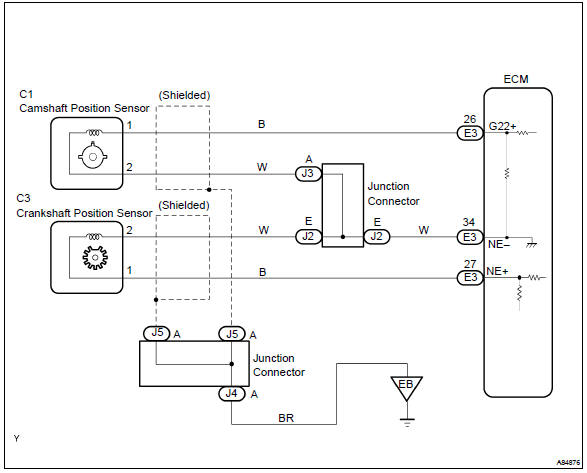Toyota Corolla (E120) 2002–2008 Repair Manual / Diagnostics / Sfi system / Crankshaft position sensor ”a”
circuit / Circuit description
Toyota Corolla (E120): Circuit description
The crankshaft position sensor (ne signal) consists of a magnet, iron core and pickup coil.
The ne signal plate (crankshaft position sensor plate) has 34 teeth and is installed on the crankshaft. The ne signal sensor generates 34 signals for each engine revolution. This sensor monitors a plate (timing rotor) located on the crankshaft timing pulley and is used by the ecm to detect crankshaft angle and engine speed (rpm/ne). As the crankshaft timing pulley rotates through an engine revolution, this sensor communicates the rotation of the ne signal plate as a pulse signal to the ecm. Based on the signal, the ecm controls fuel injection time and ignition timing.


Reference: inspection using the oscilloscope.
Hint
: the correct waveform is as shown on the left.

Monitor description
If there is no signal from the crankshaft sensor despite the engine revolving, the ecm interprets this as a malfunction of the sensor.
Monitor strategy

Typical enabling conditions

Typical malfunction thresholds

Wiring diagram

Other materials:
Initialization
Select “Initialize” using .
● Initializing the sound settings
Select “Sound setting” using and press
(YES).
For details about sound settings: ● Initializing the device information
Select “Car Device Info” using and
press (YES).
Automatic connection of a portable ...
If your vehicle overheats
The following may indicate that your vehicle is overheating.
● Vehicles without a multi-information display: The high engine coolant temperature
warning light comes on or a loss of power is experienced.
Vehicles with a multi-information display: The engine coolant temperature gauge&n ...
Circuit description
The purpose of this circuit is to prevent the engine from stalling while
driving in lock–up condition, when
brakes are suddenly applied.
When the brake pedal is depressed, this switch sends a signals to the ecm. Then
the ecm cancels the operation
of the lock–up clutch while braking is i ...


